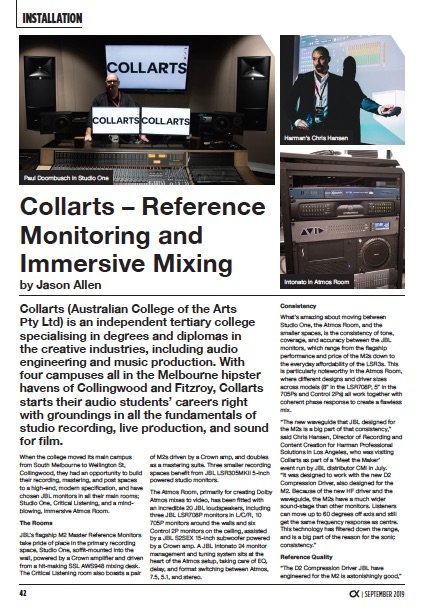News
10 Sep 2019
Collarts – Reference Monitoring and Immersive Mixing

Subscribe to CX E-News
INSTALLATION
by Jason Allen.
Collarts (Australian College of the Arts Pty Ltd) is an independent tertiary college specialising in degrees and diplomas in the creative industries, including audio engineering and music production. With four campuses all in the Melbourne hipster havens of Collingwood and Fitzroy, Collarts starts their audio students’ careers right with groundings in all the fundamentals of studio recording, live production, and sound for film.
When the college moved its main campus from South Melbourne to Wellington St, Collingwood, they had an opportunity to build their recording, mastering, and post spaces to a high-end, modern specification, and have chosen JBL monitors in all their main rooms; Studio One, Critical Listening, and a mind-blowing, immersive Atmos Room.
The Rooms
JBL’s flagship M2 Master Reference Monitors take pride of place in the primary recording space, Studio One, soffit-mounted into the wall, powered by a Crown amplifier and driven from a hit-making SSL AWS948 mixing desk.
The Critical Listening room also boasts a pair of M2s driven by a Crown amp, and doubles as a mastering suite. Three smaller recording spaces benefit from JBL LSR305MKII 5-inch powered studio monitors.
The Atmos Room, primarily for creating Dolby Atmos mixes to video, has been fitted with an incredible 20 JBL loudspeakers, including three JBL LSR708P monitors in L/C/R, 10 705P monitors around the walls and six Control 2P monitors on the ceiling, assisted by a JBL S2SEX 15-inch subwoofer powered by a Crown amp.
A JBL Intonato 24 monitor management and tuning system sits at the heart of the Atmos setup, taking care of EQ, delay, and format switching between Atmos, 7.5, 5.1, and stereo.
Consistency
What’s amazing about moving between Studio One, the Atmos Room, and the smaller spaces, is the consistency of tone, coverage, and accuracy between the JBL monitors, which range from the flagship performance and price of the M2s down to the everyday affordability of the LSR3s.
This is particularly noteworthy in the Atmos Room, where different designs and driver sizes across models (8” in the LSR708P, 5” in the 705Ps and Control 2Ps) all work together with coherent phase response to create a flawless mix.
“The new waveguide that JBL designed for the M2s is a big part of that consistency,” said Chris Hansen, Director of Recording and Content Creation for Harman Professional Solutions in Los Angeles, who was visiting Collarts as part of a ‘Meet the Maker’ event run by JBL distributor CMI in July.
“It was designed to work with the new D2 Compression Driver, also designed for the M2. Because of the new HF driver and the waveguide, the M2s have a much wider sound-stage than other monitors.
“Listeners can move up to 60 degrees off axis and still get the same frequency response as centre. This technology has filtered down the range, and is a big part of the reason for the sonic consistency.”
Reference Quality
“The D2 Compression Driver JBL have engineered for the M2 is astonishingly good,” agreed Collart’s Associate Dean, Dr Paul Doornbusch. “We’re all hearing better mid-range and more transparency in the high-end.
“To my ear, the M2s sound just as good as my personal reference, the legendary Quad ESL electrostatic loudspeakers. JBL have solved problems at the source by developing new drivers instead of retro-fitting an existing design or using DSP; it’s a fundamentally better solution.
“The R&D that JBL have put into those loudspeakers is underreported and underappreciated. It’s a fresh approach, with smart engineering, and the results are sensational.”
New Market Demand
JBL’s design goals for the M2s were driven by changes in the recording and production industry that have seen audio mixing moving from purpose-built facilities (professional studios) into renovated and adapted spaces.
The M2’s two way-design and optimised HF driver that crosses over at a surprisingly low 800Hz are both products of needing to make a ‘big’ monitor that is still ‘small’ enough to fit into most spaces, while keeping costs down by not adding a second woofer and all its attendant electronics and processing.
The demand for mixing in new and smaller spaces is even more pronounced in video and post.
As content companies like Netflix require all submissions to be in Dolby Atmos, there’s been an explosion in new environments being fitted with immersive mixing systems. “This trend is driving the design flowing from the M2s into the LSR7s,’ pointed out Chris.
“The engineers need high output to hit the Dolby SPL spec at the mix position, with even frequency response and ultra-low distortion. The waveguide design matched with new compression driver and two new woofer models used in the LSRs have achieved this.”
Future Proofing
Dr Doornbusch sees the Atmos Room at Collarts as essential for preparing their students for the immediate future of the industry; “I see a world where there will be convergence of gaming, cinema, and VR.
“The audio industry should be moving towards a ‘produce once and deliver’ workflow where we mix to a standard such as Dolby Atmos which then renders at playback to suit the equipment it’s being reproduced on, whether that’s Atmos, 7.1, 5.1, stereo, or Ambisonics. I think VR and gaming are definitely moving that way.”
The Atmos Room’s mix of 708Ps, 705Ps, and Control 2Ps was arrived at to satisfy a Dolby Atmos specification. “A lot of studios are mixing with the Dolby minimum recommendation of nine loudspeakers,” related Dr Doornbusch, “but we wanted to go for something more impressive.
“The consistency of phase and voicing across the different models used in the Atmos Room is impressive and as good as I’ve ever heard. The 708Ps and 705Ps are highly comparable, with a little more bottom detectable in the 8s, but remarkably, not a big difference in the mid-range.”
With a range of strong competitors in the monitoring space, Collarts chose JBL monitors for their performance and price. “The decision was partially financial, and partially on the results,” confirmed Dr Doornbusch.
“Other monitoring solutions were similarly priced, or more expensive, and the JBL range simply gave better audio performance across the applications.”
“Collarts students now have access to studios, a mastering suite, and an Atmos room with a quality of sound reproduction they can’t get anywhere else,” Dr. Paul Doornbusch concluded.
“Even if they have decent monitors at home, you just can’t get the lower couple of octaves, the lower distortion, surround, or treated rooms without spending the money.
“Our students are now receiving a premium audio education, and that gives them every reason to come and work on campus. It also establishes a benchmark for them, so when they graduate and are working in the industry, and are in a position to specify equipment, they can specify something that sounds just as good.”
CX Magazine – Sept 2019 Entertainment technology news and issues for Australia and New Zealand – in print and free online www.cxnetwork.com.au
© CX Media
Subscribe
Published monthly since 1991, our famous AV industry magazine is free for download or pay for print. Subscribers also receive CX News, our free weekly email with the latest industry news and jobs.















